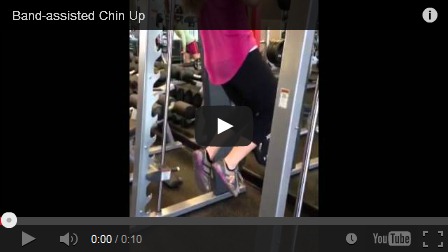Some thoughts and discussions from me.
I wrote on my Facebook page last week that one of my female clients proclaimed to me that she wanted to be able to perform a chin up as one of her in-the-gym goals. This is a goal of many of my female clients, and I’m enthralled each time one tells me it’s a goal they would like to achieve!
From there, we work – nearly in almost every session – on completing that goal. This was once a goal of mine, and it’s one of the best feelings to be able to propel yourself into the air and over that bar for the first time – unassisted. Now my goal is to complete a set of 10. (And FYI – if you’re signed up for YTP online boot camp, we’ll be working on chin ups/chin up variations in month 2!)
How to get there? Easy – do a crap ton of assisted chin ups, for starters. But, as always, there’s more to it ![]()
Disclaimer: As always, consult with your physician before beginning any new diet or exercise program.
1. Use resistance bands for assistance.
Unless you have someone who can spot you, opt for using resistance bands to help assist you in your chin ups over a machine. Simply hook the band around a straight bar, and put your foot or knee in the band. Resistance bands help you most at the bottom of the motion, where you need it most, and less and less as you pull to the top of the motion.
2. Don’t go to failure.
Don’t let your form break down by going to failure. As soon as one rep looks even slightly sloppy, that set is DONE. If 5 chin ups or assisted chin ups is your max, stop at 3-4. Then rest, and perform another set. Stay below your max effort to see gains in your chin up. That said…
3. Do a crap ton of (assisted) chin ups.
Yes, that’s the official amount ![]() Kidding – but volume is key! I generally aim to get in 25-30 reps each time I do chin ups. That might mean 5-6 sets of of 4-5 chin ups if I’m using a thin band or no band at all. Also make sure to rest 30-60 seconds in between sets.
Kidding – but volume is key! I generally aim to get in 25-30 reps each time I do chin ups. That might mean 5-6 sets of of 4-5 chin ups if I’m using a thin band or no band at all. Also make sure to rest 30-60 seconds in between sets.
4. Use different grips.
I prefer either a neutral or underhand grip when first starting out. Using a neutral grip a little easier on the shoulders, plus, it fires slightly different motor units than the standard underhand grip. Adding in an overhand, wide grip lat pull down will be helpful, too.
5. Perform negative chin ups.
This trains the eccentric portion of the chin up, aka the downward portion. You can do this with a band, but ultimately you want to try it without. You can do this by jumping up to the bar, as seen in my video above. And when you extend back down, you want to go excruciatingly slow. Take maybe 20-30 seconds to fully extend the elbows and the scapulae. It increases time of tension without increasing reps or going to failure. Which is a nice segue to…
6. Make sure you’re retracting your scapulae.
Pack your shoulders down and back by “firing” or retracting the scapulae. At the top of the motion, pull your chest to the bar by really retracting and depressing those scaps.
7. Improve your grip strength
Often times, what breaks down chin up form for women is grip strength. Don’t let a poor grip hinder your chin up. Start adding in farmers walks, deadlifts, and plate pinches to your workouts.
8. Make sure to fully extend at the bottom of the motion.
This not only helps range of motion and mobility, but also ensures you’re completing a full rep. It’s easy to only go down about 5/6 of the way, and then pull back up, but then you’re missing out on the toughest part of the chin up – the bottom of it!
9. Foam roll the lats.
Soft tissue work will help you get full mobility by breaking through any built up hard or scar tissue getting in your way.
Chin ups: love ‘em? hate ‘em?
What’s one of your in-the-gym goals right now?
For more inspiration, workouts, and pictures, check out my social media pages:
Twitter: @TrainerPaige
Instagram: @TrainerPaige
Facebook: Your Trainer Paige
Bloglovin’: Your Trainer Paige
Pinterest: TrainerPaige







I FREAKING LOVE THEM! I do them all upper body days cause I am practicing too 😀
Meg @ A Dash of Meg recently posted…April/May Workout Program
Yes Paige! This is on my to do list, just in case I ever fall of the side of a cliff, I will know I can pull myself up 😛 I may be able to run faster than most, but my weakling little arms can only dream of pull ups. I have been using the negative chin ups, and the bands to try to strengthen my body to try. Hopefully I get there eventually!
Thanks for sharing more tips! This is my go to goal….in the gym. My go to running goal is to run 1:13 next month in my half marathon 🙂
Tina Muir recently posted…Meatless Monday: Mango and Sweet Potato Tacos
Exactly! haha, you never know. And WOW – you are fast!
WONDERFUL resource post, friend!!! Can’t wait to get back to pullups!
Lindsay @ Lindsay’s List recently posted…pregnancy – 39 weeks
Haha I love Tina’s reason for wanting to get a chin up :-p I’d love to be able to get more – I think the last time I checked I could do about 4 unassisted? Something for me to work on!
Sam @ Better With Sprinkles recently posted…Why I Wasn’t Convinced by “It Starts With Food”.
Excellent “How To”! This is exactly how I progressed to unassisted pull ups:)
Whoop whoop! Way to go, Tracey:)
Thank you thank you thank you for this! This is one of my top fitness goals for the next year, and you broke it down so I know exactly how to work on them.
Good for you, Dana! And you are so welcome 🙂
One of my FAVORITE moves in the gym! Great progression post, Paige. I’m doing a challenge where you start at 1 and add a single rep to to 3 moves each day for 60 days – push ups, lunges and pull ups – in addition to your regular workouts. I’m on day 15 today…starting to break them up into sets now. 😉 I did a similar post of progressions b/c I, too, love when women ask about them! I’d also say doing inverted rows to start (under a bar) to work up and then inverted rows with a towel grip to keep working on group strength. Great post!
Bonnie recently posted…X2Performance Video Review
Bonnie, you are a rock star. I’d love to workout with you some day!
Thanks for all these great tips! I’ll be workin’ on them for sure. I’m totally guilty of not extending all the way…At least I know to go alllllll the way down now 😉
Alison @ Daily Moves and Grooves recently posted…I Have Awesome Friends
this is def one of my goals!! Thanks girl… and I’m so glad we will be working on this in bootcamp!!
Brittany @ Delights and Delectables recently posted…WIAW: Hangry Day
I would so LOVE to be able to do a chin up. Just one! I am so weak in my upper body in comparison to my lower body though. Plus, I weight a lot at the moment so maybe that makes it even harder? I used to love assisted chin ups, but sadly my current gym doesn’t have that machine. Is there anything else I can do to help me work towards chin ups? Keeping in mind that I literally could not get myself up there to do even one. I just hang like a freaked out cat falling from a tree or something.
samantha recently posted…Raw food diet – Fad or Fab?
That’s such a great goal!! I do a lot more pull-ups than chin-ups so I always feel awkward trying the chin-up grip. I learned this month that you can also do a mixed grip, and that helps you if you want to do a chest-to-bar pull-up! Fun. And definitely the way I learned was practicing every single day!!!
Corrie Anne recently posted…Day 2 & Real Comfort
Hey Peige, Excellent Goal and thanks for all these great tips.